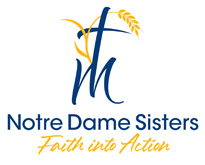Celebrating the Assumption of Mary, Jesus’ mother, into Heaven
by Sr. Mary Ann Zimmer, ND
If you can’t think of where the Assumption of Mary is mentioned in the New Testament, you didn’t miss that lesson. It is not there. The belief that Mary was taken bodily to be with Christ at the end of her life, is not in the scriptures. Like any title or honor applied to Mary, it is, in some form, a meditation on Jesus and salvation, and though it does apply to Mary as a “special case,” it also has application to all of us.
Christian teaching about Mary is always treading a fine line between the ordinary and the unique. Everything said about Mary must include her real and complete humanity. It is Mary’s humanity that anchors Christian belief in Christ’s humanity as complete and real. His mother was fully human and that is the basic argument for holding on to belief in Jesus’ own humanity. This was argued clearly in early church councils that hammered out dogma about the nature of Jesus Christ. It is even expressed in the history of Christian art that frequently showed Mary nursing Jesus. This is not just a pretty picture, but a visual argument for belief in Jesus’ humanity; this is a human child being nourished in the usual human way by a human mother.
Unique comes in because of Mary’s role as the mother of Jesus. In Christian belief she is a person like no other. Christian doctrine about Mary has arisen from pondering what is fitting to think and say about her because of this role. Early Christians did not think it fitting that she should know original sin; on the other hand, she shares the human condition. They solved this dilemma by arguing that she was ordinarily human, of course, but the redemption that would be applied to all of us through Christ’s life, death, and resurrection, could fittingly be said to apply to her from her conception. [Too brief, I know.]
Belief in the Assumption comes from a similar line of thought. If the decay of the body is a consequence of original sin, shouldn’t Mary be preserved from that? Several schools of thought argued over significant details, however. If we say that she was assumed bodily before death, that ignores her real humanity; see the problem? On the other hand, some were not willing to concede that she could have died if that is also a consequence of original sin. In the end, the church punted. The official teaching says that “when the course of her earthly life was finished, she was taken up body and soul into heavenly glory.” This neither denies nor affirms her death!
If you are still with me, you might be wondering about the point of all this! Are theologians arguing about some esoteric, imaginary zipline to heaven? This question brings us back to the importance of Mary’s real, full humanity. Everything said about her is said in light of God’s redeeming love. In this case, it highlights the fact that God’s redeeming love, applied to her in a unique sequence, is our future also. The redeeming love that honors her body also applied to ours. We, body and soul, flesh and spirit, are living in the time of the redemption. Our bodies are not an impediment to redemption but are an integral part of it—as are the bodies of our neighbors with whom we share the earth. How do we accept a deep realization of that blessed reality? How do we embody as best we can redemptive love where we are situated?
As Notre Dame Sisters, August 15 is a day to remember a particular band of people who embodied redemptive love in their time and place. This feast has always been special to us because on this day the first two Notre Dame Sisters made vows in the tiny parish church of the Good Shephard in Hirschau, Bohemia. Six young women were received as novices. Thus, the congregation you know today as the Notre Dame Sisters was born.
In a village where the education of girls was shamefully neglected, the pastor, Fr. Gabrial Schneider had dreamt of a school staffed by Sisters who would nourish the minds and spirits of local girls. His efforts failed repeatedly. He sought help from established women’s orders in Austria and Bavaria. He sent young women for education and training. He found donors and built a school and convent, but after seven years the school remained empty for lack of teachers. Finally, he determined that he, with the dedicated young women who had been devoted to this effort, and their supporters would have to create a new religious order. This was the only way to ensure education for girls in this poor village.
Today we celebrate 170 years of countless lives touched by the struggles and dreams of these early founders and all who have followed in their spirit. We know that like Mary, our own lives rely on God’s redemptive love–ours to receive and ours to give. On this feast dedicated to God’s redemptive love we pray one of Fr. Gabriel’s favorite prayers:
“We are completely overwhelmed by your goodness and providence, O God.”
